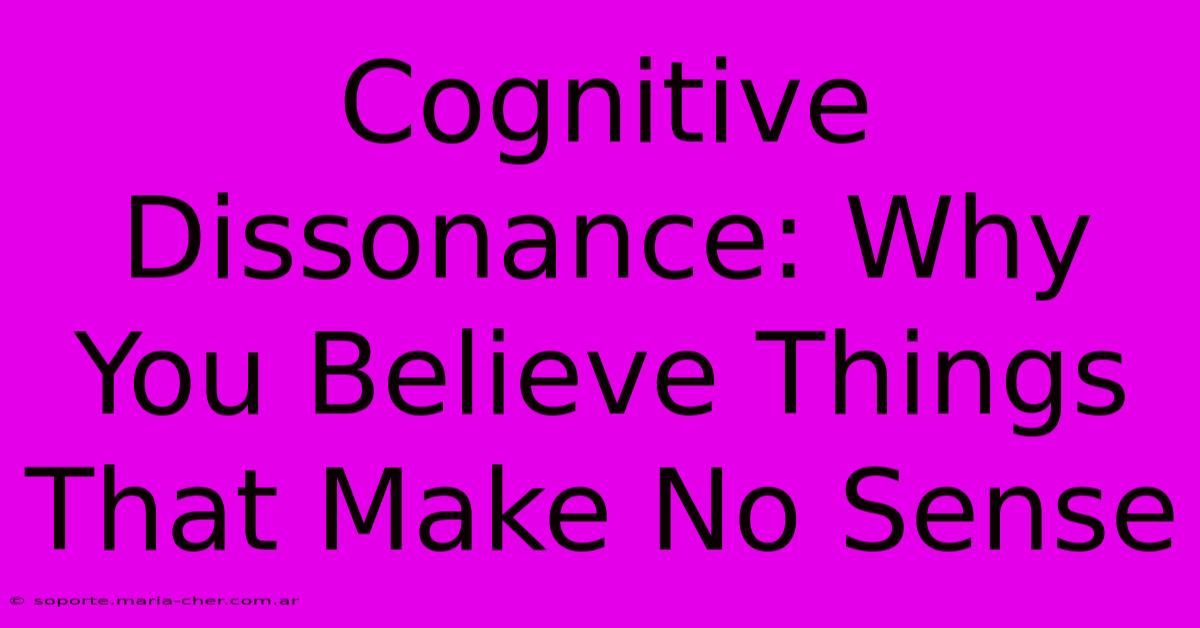Cognitive Dissonance: Why You Believe Things That Make No Sense

Table of Contents
Cognitive Dissonance: Why You Believe Things That Make No Sense
We all hold beliefs, sometimes strongly, even when confronted with contradictory evidence. This isn't necessarily a sign of stubbornness or foolishness; it's often a manifestation of cognitive dissonance, a fascinating psychological phenomenon. This article delves into the core of cognitive dissonance, exploring its causes, effects, and how to navigate its often-uncomfortable implications.
Understanding Cognitive Dissonance: The Core Concept
Cognitive dissonance is the mental discomfort experienced by a person who holds two or more contradictory beliefs, ideas, or values. This discomfort arises when actions clash with beliefs, or when two cherished beliefs conflict. Think of it as your brain's built-in alarm system signaling an internal inconsistency. The more significant the discrepancy, the greater the dissonance.
Example: A person who strongly values environmental protection but frequently drives a gas-guzzling SUV experiences cognitive dissonance. The action (driving the SUV) contradicts the belief (environmental protection).
Key Elements of Cognitive Dissonance:
- Dissonance Arousal: The initial feeling of discomfort triggered by the conflicting beliefs or actions.
- Dissonance Reduction: The mental strategies employed to lessen the discomfort and restore internal consistency.
- Motivated Reasoning: The subconscious tendency to interpret information in a way that confirms existing beliefs and reduces dissonance.
How Cognitive Dissonance Manifests
Cognitive dissonance manifests in various ways, subtly influencing our thoughts, feelings, and behaviors. Here are some common examples:
- Changing Beliefs: To reduce dissonance, you might adjust your beliefs to align with your actions. For instance, the SUV driver might start downplaying the impact of their vehicle's emissions.
- Justifying Actions: Alternatively, you might rationalize your actions to make them seem consistent with your beliefs. The driver might justify their SUV purchase by emphasizing its safety features or off-road capabilities.
- Ignoring Conflicting Information: This involves actively avoiding information that challenges your existing beliefs to maintain a sense of internal consistency. The driver might avoid articles about climate change or fuel efficiency.
- Seeking Supporting Evidence: You might actively seek out information that supports your existing beliefs and dismiss evidence that contradicts them.
The Effects of Cognitive Dissonance
The impact of unresolved cognitive dissonance can be significant. It can lead to:
- Stress and Anxiety: The constant internal conflict can lead to feelings of unease and stress.
- Poor Decision-Making: Attempts to reduce dissonance can cloud judgment and lead to suboptimal choices.
- Resistance to Change: Holding onto dissonant beliefs can hinder personal growth and prevent necessary changes in behavior.
- Confirmation Bias: The tendency to favor information that confirms pre-existing beliefs, further reinforcing dissonance.
Reducing Cognitive Dissonance: Strategies for Resolution
Fortunately, there are strategies to manage and reduce cognitive dissonance:
- Self-Reflection: Honestly examine your beliefs and actions, identifying potential conflicts.
- Seeking Balanced Information: Actively expose yourself to diverse perspectives and information, even if it challenges your views.
- Open-mindedness: Cultivate a willingness to reconsider your beliefs and adapt your thinking when presented with compelling evidence.
- Mindful Decision-Making: Before making important decisions, carefully weigh the potential consequences and assess their alignment with your values.
Cognitive Dissonance in Everyday Life: Examples
Cognitive dissonance is not just an abstract psychological concept; it plays a significant role in many aspects of our daily lives. Consider these examples:
- Smoking: Smokers often experience dissonance between the knowledge that smoking is harmful and the continued act of smoking. They might rationalize their habit or downplay the risks.
- Political Beliefs: Holding strong political beliefs can lead to dissonance when confronted with facts that contradict those beliefs. Individuals might selectively process information to reduce this discomfort.
- Relationship Conflicts: Romantic relationships can be fraught with dissonance when partners hold conflicting values or expectations. This can lead to arguments and relationship strain.
Conclusion: Embracing Dissonance for Growth
Cognitive dissonance is an inherent part of the human experience. While it can be uncomfortable, it also presents an opportunity for growth and self-awareness. By acknowledging dissonance, engaging in self-reflection, and actively seeking balanced information, we can navigate its complexities and cultivate a more accurate and nuanced understanding of ourselves and the world around us. Learning to manage cognitive dissonance is a key skill for personal development and making rational decisions. Understanding this psychological phenomenon enables us to make better choices and live more authentically.

Thank you for visiting our website wich cover about Cognitive Dissonance: Why You Believe Things That Make No Sense. We hope the information provided has been useful to you. Feel free to contact us if you have any questions or need further assistance. See you next time and dont miss to bookmark.
Featured Posts
-
March Madness More Like Laugh Madness The Silliest Team Names In Basketball
Feb 07, 2025
-
Ditch The Clutter Embrace The Void The Ultimate Guide To Empty Effective Flyer Design
Feb 07, 2025
-
Supercharge Your Wireframes With The Data Driven Force Of Our Catalog
Feb 07, 2025
-
Elevate Your Wrist With The Chic And Affordable Charm Of Gold Vermeil Bracelets
Feb 07, 2025
-
Decode The Subtlety Response Bias And Its Impact On Advance Decisions
Feb 07, 2025
